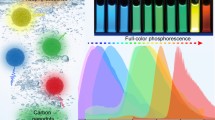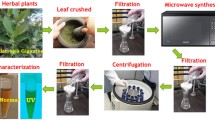Abstract
Inorganic-organic optical probe based on lanthanide emission will provide a new way for specific applications. In this work, sarcosine and urea are selected as raw materials to synthesize carbon dots with cyan-emissive color. In the next step, indicator components (Ethylene Diamine Tetraacetic Acid and lanthanide ions) are incorporated onto carbon quantum dots (CQDs) and the flexible alginate hydrogel is employed as the host to accommodate the emissive species. The soft material can exhibit typical red and green emissions. Its luminescence is responsive to calcium ions and the detection limit has been calculated to be 0.84 μM and 0.92 μM respectively. Such optical device can be employed as a portable probe in a variety of scientific fields due to its convenience and flexibility.







Similar content being viewed by others

Availability of Data and Material
All data generated or analyzed during this study are included in this published article.
Code Availability
Not applicable.
References
Qin M, Sun M, Bai R, Mao Y, Qian X, Sikka D, Zhao Y, Qi HJ, Suo Z, He X (2018) Bioinspired Hydrogel Interferometer for Adaptive Coloration and Chemical Sensing. Adv Mater 30(21):e1800468. https://doi.org/10.1002/adma.201800468
Fu X, Wang P, Miao Q, Liu K, Liu H, Liu J, Fang Y (2016) Polymerizable organo-gelator-stabilized gel-emulsions toward the preparation of compressible porous polymeric monoliths. J Mater Chem A 4(39):15215–15223. https://doi.org/10.1039/c6ta05070k
Liu S, Ling J, Li K, Yao F, Oderinde O, Zhang Z, Fu G (2017) Bio-inspired and lanthanide-induced hierarchical sodium alginate/graphene oxide composite paper with enhanced physicochemical properties. Compos Sci Technol 145:62–70. https://doi.org/10.1016/j.compscitech.2017.01.009
Podder D, Nandi SK, Sasmal S, Haldar D (2019) Synergistic Tricolor Emission-Based White Light from Supramolecular Organic-Inorganic Hybrid Gel. Langmuir 35(19):6453–6459. https://doi.org/10.1021/acs.langmuir.9b00456
Mohamed AK, Mahmoud ME (2020) Encapsulation of starch hydrogel and doping nanomagnetite onto metal-organic frameworks for efficient removal of fluvastatin antibiotic from water. Carbohydr Polym 245:116438. https://doi.org/10.1016/j.carbpol.2020.116438
Heo G, Son K, Jeong YH, Kim CG, Do JY (2017) Development of 1,2- and 1,3-Ketohydrazones Derived Rhodamine Chromophores Sensitive to Metal Ions and pH. J Nanosci Nanotechnol 17(8):5652–5655. https://doi.org/10.1166/jnn.2017.14116
Kim JU, Kim YK, Yang H (2010) Reverse micelle-derived Cu-doped Zn(1-x)Cd(x)S quantum dots and their core/shell structure. J Colloid Interface Sci 341(1):59–63. https://doi.org/10.1016/j.jcis.2009.09.039
Ye S, Xiao F, Pan YX, Ma YY, Zhang QY (2010) Phosphors in phosphor-converted white light-emitting diodes: Recent advances in materials, techniques and properties. Mater Sci Eng R 71(1):1–34. https://doi.org/10.1016/j.mser.2010.07.001
Wang F, Chen P, Feng Y, Xie Z, Liu Y, Su Y, Zhang Q, Wang Y, Yao K, Lv W, Liu G (2017) Facile synthesis of N-doped carbon dots/g-C3N4 photocatalyst with enhanced visible-light photocatalytic activity for the degradation of indomethacin. Appl Catal B 207:103–113. https://doi.org/10.1016/j.apcatb.2017.02.024
Qiao G, Chen G, Wen Q, Liu W, Gao J, Yu Z, Wang Q (2020) Rapid conversion from common precursors to carbon dots in large scale: Spectral controls, optical sensing, cellular imaging and LEDs application. J Colloid Interf Sci 580:88–98. https://doi.org/10.1016/j.jcis.2020.07.034
Genc R, Alas MO, Harputlu E, Repp S, Kremer N, Castellano M, Colak SG, Ocakoglu K, Erdem E (2017) High-Capacitance Hybrid Supercapacitor Based on Multi-Colored Fluorescent Carbon-Dots. Sci Rep 7(1):11222. https://doi.org/10.1038/s41598-017-11347-1
Konar S, Kumar BNP, Mahto MK, Samanta D, Shaik MAS, Shaw M, Mandal M, Pathak A (2019) N-doped carbon dot as fluorescent probe for detection of cysteamine and multicolor cell imaging. Sensor Actuat B: Chem 286:77–85. https://doi.org/10.1016/j.snb.2019.01.117
Ma H, Sun C, Xue G, Wu G, Zhang X, Han X, Qi X, Lv X, Sun H, Zhang J (2019) Facile synthesis of fluorescent carbon dots from Prunus cerasifera fruits for fluorescent ink, Fe(3+) ion detection and cell imaging. Spectrochim Acta A 213:281–287. https://doi.org/10.1016/j.saa.2019.01.079
Liu Y, Yang H, Ma C, Luo S, Xu M, Wu Z, Li W, Liu S (2020) Luminescent Transparent Wood Based on Lignin-Derived Carbon Dots as a Building Material for Dual-Channel, Real-Time, and Visual Detection of Formaldehyde Gas. ACS Appl Mater Interf 12(32):36628–36638. https://doi.org/10.1021/acsami.0c10240
Dong H, Du S-R, Zheng X-Y, Lyu G-M, Sun L-D, Li L-D, Zhang P-Z, Zhang C, Yan C-H (2015) Lanthanide Nanoparticles: From Design toward Bioimaging and Therapy. Chem Rev 115(19):10725–10815. https://doi.org/10.1021/acs.chemrev.5b00091
Wu S, Lin Y, Liu J, Shi W, Yang G, Cheng P (2018) Rapid Detection of the Biomarkers for Carcinoid Tumors by a Water Stable Luminescent Lanthanide Metal-Organic Framework Sensor. Adv Funct Mater 28(17). https://doi.org/10.1002/adfm.201707169
Wang F, Liu X (2014) Multicolor tuning of lanthanide-doped nanoparticles by single wavelength excitation. Acc Chem Res 47(4):1378–1385. https://doi.org/10.1021/ar5000067
Wang H, Ke F, Mararenko A, Wei Z, Banerjee P, Zhou S (2014) Responsive polymer-fluorescent carbon nanoparticle hybrid nanogels for optical temperature sensing, near-infrared light-responsive drug release, and tumor cell imaging. Nanoscale 6(13):7443–7452. https://doi.org/10.1039/c4nr01030b
Drury JL, Mooney DJ (2003) Hydrogels for tissue engineering: scaffold design variables and applications. Biomaterials 24(24):4337–4351. https://doi.org/10.1016/s0142-9612(03)00340-5
Lee KY, Mooney DJ (2012) Alginate: properties and biomedical applications. Prog Polym Sci 37(1):106–126. https://doi.org/10.1016/j.progpolymsci.2011.06.003
Peppas NA, Hilt JZ, Khademhosseini A, Langer R (2006) Hydrogels in Biology and Medicine: From Molecular Principles to Bionanotechnology. Adv Mater 18(11):1345–1360. https://doi.org/10.1002/adma.200501612
Slaughter BV, Khurshid SS, Fisher OZ, Khademhosseini A, Peppas NA (2009) Hydrogels in regenerative medicine. Adv Mater 21(32–33):3307–3329. https://doi.org/10.1002/adma.200802106
Ma Q, Wang Q (2015) Lanthanide induced formation of novel luminescent alginate hydrogels and detection features. Carbohydr Polym 133:19–23. https://doi.org/10.1016/j.carbpol.2015.07.017
Zhou Z, Li XQ, Tang YP, Zhang CC, Fu HR, Wu NT, Ma LF, Gao JW, Wang QM (2018) Oxidative deoximation reaction induced recognition of hypochlorite based on a new fluorescent lanthanide-organic framework. Chem Eng J 351:364–370. https://doi.org/10.1016/j.cej.2018.06.123
Li XQ, Gu JP, Zhou Z, Ma LF, Tang YP, Gao JW, Wang QM (2019) New lanthanide ternary complex system in electrospun nanofibers: Assembly, physico-chemical property and sensor application. Chem Eng J 358:67–73. https://doi.org/10.1016/j.cej.2018.10.003
Liu XY, Gao JW, Zhou GF, Liu WQ, Wang QM, Zheng YH (2020) Low molecular weight molecule induces the effective stabilization of CsPbBr3 in water. J Mol Liq 299:112199. https://doi.org/10.1016/j.molliq.2019.112199
Caffrey DF, Gunnlaugsson T (2014) Displacement assay detection by a dimeric lanthanide luminescent ternary Tb(III)-cyclen complex: high selectivity for phosphate and nitrate anions. Dalton Trans. 43:17964–17970. https://doi.org/10.1039/C4DT02341B
Qiao GX, Liu L, Hao XX, Zheng JK, Liu WQ, Gao JW, Zhang CC, Wang QM (2020) Signal transduction from small particles: Sulfur nanodots featuring mercury sensing, cell entry mechanism and in vitro tracking performance. Chem Eng J 382:122907. https://doi.org/10.1016/j.cej.2019.122907
Zhou Z, Wang QM, Wang JY, Zhang CC (2015) Imaging two targets in live cells based on rational design of lanthanide organic structure appended carbon dots. Carbon 93:671–680. https://doi.org/10.1016/j.carbon.2015.05.107
Lakowicz JR (2006) Principles of Fluorescence Spectroscopy. Springer-Verlag Berlin Heidelberg.
Funding
Q. M. appreciates the support from Science and Technology Plan of Guangdong Province (No. 2020A0505100055), Guangzhou Science and Technology Plan (No. 202002030325), Science and Technology Program of Guangzhou (No. 201905001) and Guangdong Provincial Key Laboratory of Optical Information Materials and Technology (No. 2017B030301007). Q. Wen thanks for the support from Innovation Project of Graduate School of South China Normal University (2019LKXM009).
Author information
Authors and Affiliations
Contributions
Qin Wen: Conceptualization, Investigation, Writing - original draft.
Yuhui Zheng: assisted with data collection and data analysis..
Wanqiang Liu: assisted with data collection and visualization.
Qianming Wang: Supervision, funding acquisition, writing and reviewing.
Corresponding authors
Ethics declarations
Ethics Approval
This manuscript is not currently under consideration, in press or published elsewhere and is truthful original work without fabrication, fraud or plagiarism.
Consent to Participate
Not applicable.
Consent for Publication
Not applicable.
Conflicts of Interest
The authors declare that non conflicts of interest.
Additional information
Publisher’s Note
Springer Nature remains neutral with regard to jurisdictional claims in published maps and institutional affiliations.
Supplementary Information
ESM 1
(DOCX 550 kb)
Rights and permissions
About this article
Cite this article
Wen, Q., Zheng, Y., Liu, W. et al. Stepwise Assembly Protocols for the Rational Design of Lanthanide Functionalized Carbon Dots-Hydrogel and its Sensing Evaluation. J Fluoresc 31, 695–702 (2021). https://doi.org/10.1007/s10895-021-02694-4
Received:
Accepted:
Published:
Issue Date:
DOI: https://doi.org/10.1007/s10895-021-02694-4



